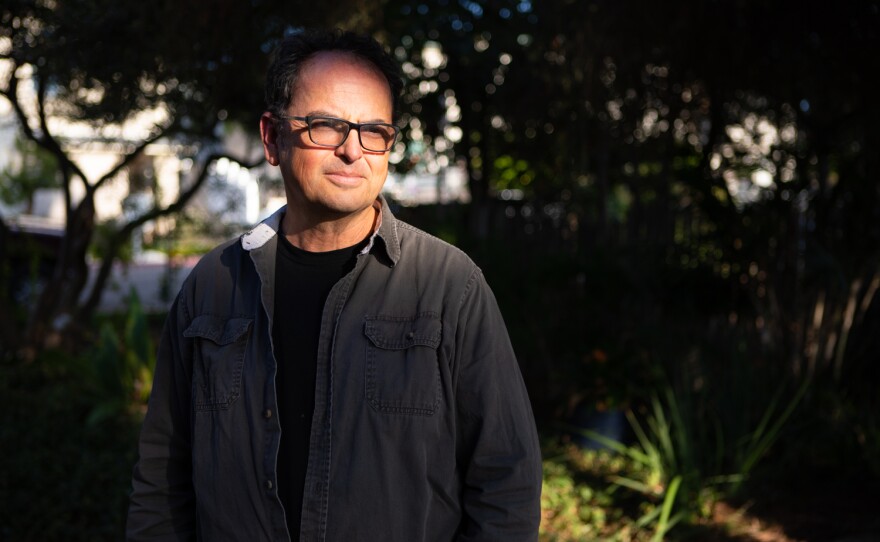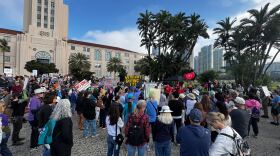The husband and wife team at the helm of a high-profile San Diego nonprofit ignited a bitter controversy by taking charitable donations valued at nearly $70,000 out of the state for their personal use. The conflict strained San Diego’s insular historic preservation community, led to a board member’s resignation, sparked retaliation concerns and prompted an overhaul of the institution’s policies.
With no permission and little documentation, the longtime leaders of Save Our Heritage Organisation (SOHO) shipped a trove of antiques to their private mansion in Mississippi, where the objects stayed for more than two years, until complaints were made.
SOHO manages historic house museums and fights the destruction of historic properties throughout San Diego County. The nonprofit, which oversees more than $4 million in assets, has helped preserve some of the most iconic pieces of architecture in the region, including the Cabrillo Bridge in Balboa Park and the Western Metal building in Petco Park.
The organization also accepts donations of antiques to display inside its historic properties or sell to members of the public to bring in revenue.
Bruce Coons, SOHO’s executive director, and his wife Alana Coons, the education and communications director, have spearheaded the institution for more than two decades and are considered juggernauts of historic preservation in San Diego.
The accusations against the Coons surround their use of dozens of antiques donated to the nonprofit over a four-year period. The items in dispute include a French liqueur case with an appraisal value of $7,500, two pairs of Louis XV style candlesticks valued at a total of $18,400 and steel grape shears valued at $2,500.
In 2019, the Coons put some of the SOHO antiques on display during a historic home tour in Mississippi and received a cut of the proceeds from the event.
Two years later, a real estate listing for the Coons’ two-story, 5,000 square foot property appeared online, along with photos of the SOHO donations and a description that said “original antiques” came with the purchase.
During interviews, the Coons said they loaned the antiques to themselves for the home tour — without seeking approval from the board of directors or anyone else. They acknowledged their use of the items was a mistake, but they steadfastly denied claims that they misused SOHO donations, personally benefited from them or attempted to sell them.

The couple provided an inventory of the items for sale with their estate, which did not include any of the SOHO antiques.
“Our entire life, everything we do is dedicated to helping and growing and building, so this just goes completely against anything and everything that anyone knows about us or who we are,” Alana Coons said.
The Coons said they were already working on returning the donations before they became aware of the complaints against them, and at that point, they quickly shipped all the objects back to San Diego.
Longtime preservationists told inewsource that the controversy at SOHO is highly unusual and easily preventable if donations are tracked and loans are documented. The paper trail of the Coons’ loan is incomplete, leaving members of the nonprofit worried that not all of the antiques were located and returned.
Lax oversight and poor recordkeeping pose major problems for institutions trying to prevent or investigate possible workplace misconduct, experts said.
“It strikes me as a pretty good example of how smaller operations, oftentimes they’re vulnerable to fraud because there’s a lot of trust among the staff,” said Mason Wilder, research manager at the Association of Certified Fraud Examiners, who was not concluding if any wrongdoing occurred at SOHO.
“That trust can be manifested in a lack of controls or policies,” he added.
Earlier this year, SOHO’s board of directors agreed to hire an independent auditor to review the situation. In a controversial move, they chose a certified public accountant who has worked on SOHO’s tax returns for more than 20 years.
The accountant concluded that no misappropriation occurred at SOHO, and in July, he reported that all the donations were returned. Days later, a longtime staff member who had shared his concerns about the antiques was let go. The reason cited was a lack of funding for his position.
SOHO recently adopted new policies for accepting and overseeing donations, which now involve board approval.
“We’re making this up as we go on,” Bruce Coons said. “We’ve been entrepreneurial in fashion, and we’re learning.”
Preservation groups like SOHO use buildings, paintings, clothing, furniture and other items to educate the public and form connections between communities that live decades or centuries apart.
Claims of wrongdoing in the industry, even if they are unfounded, can have far-reaching consequences. Public skepticism can lead to fewer donations of cash or historical items and stall efforts to preserve cultural artifacts.
“It can undermine confidence in the integrity of other similar historical preservation organizations, such as historic houses and museums,” said Dale Carolyn Gluckman, former curator at the Los Angeles County Museum of Art and longtime museum professional.
“It can rob present and future generations of important historical information, of everyone’s history.”
A house in Mississippi
When Christopher Pro was handed a list of antiques, he didn’t ask questions.
Pro worked with SOHO for two decades. He briefly served on its board of directors and, until his staff position was phased out in July, he maintained the grounds at the nonprofit’s historic properties.
Outside of work, Pro was a longtime friend of the Coons. In 2017, he traveled with them as they searched for a historic home to live in when they retired. The Coons eventually settled on an estate in Natchez, a small city nestled up against the Mississippi River.

In 2019, the Coons asked Pro to participate in his free time as an assistant for a historic home tour at their new Mississippi property. Alana Coons requested he box up some SOHO antiques and ship them to her estate before the tour began, Pro said. But he didn’t understand why they were being used for an event that had no connection to the organization.
“There’s no reason to loan out sterling silver teaspoons or a decanter set that’s so fragile, to be shipping it (more than) 1,300 miles away,” Pro said. “Those items should have been in a secure location.”
SOHO leadership said the organization has a history of loaning antiques to homeowners for tours. But they acknowledged they’ve never loaned items to a home tour outside of San Diego County before the one at the Coons’ Mississippi mansion.
What is a historic home tour?
Historic home tours are performed around the country and allow community members to visit properties that have architectural or historical significance.
Owners of historic homes can agree to open up their properties for the event and teach the public about different styles of architecture. Docents, or tour guides, may walk people around the property and offer information about the house to guests.
For many years, SOHO organized its own event called the Annual Home Tour, a big fundraising opportunity for the organization, that allowed San Diegans to explore unique historic properties in the region.
According to staff at Natchez Pilgrimage Tours, which organized the event in Mississippi, homeowners receive payment for participating. They earn a percentage of ticket sales proportional to the number of guests who visit their property.
During the event, Pro said he became concerned enough about SOHO’s antiques that he took pictures of them for safe keeping. The photos, later shared with inewsource, show ornately designed furniture and dinnerware throughout the house — a dessert setting carefully placed around a dining table, intricately patterned bed coverings in the sleeping quarters and elaborately crafted rosewood chairs in the living room.
Worried about possible retaliation for speaking out, Pro said he kept his suspicions to himself. But he slowly developed doubts about how other SOHO donations were being used, he said. Among his concerns were three framed, historical posters of San Diego, valued at $8,100, which he said he saw hanging on the walls at the Coons’ personal home in Point Loma.
Finally, last November, Pro sat down with the president of the board of directors to discuss his concerns.
Weeks later, the Coons posted their Mississippi home for sale with a price tag of $1.95 million. The real estate listing featured photos of antiques inside the house, some belonging to SOHO, as well as the sentence: “Sold fully furnished including original antiques.”
The listing prompted more complaints to the board.

Will Chandler, a personal property appraiser and former associate curator at the San Diego Museum of Art, said he was shocked to see photos of items he had appraised for SOHO inside the Coons’ home halfway across the country.
Chandler said the Coons’ behavior went against the principles and best practices in the preservation industry.
“It was so disappointing to me,” he said.
‘Poor judgment and a mistake’
Asset misappropriation, which involves misusing an employer’s cash or property for personal gain, is a widespread issue affecting nonprofits and other businesses. It’s the biggest category of occupational fraud that companies face, according to a 2022 report by the Association of Certified Fraud Examiners.
Jim Vogt, a certified fraud examiner and lecturer at San Diego State University’s accountancy school, said an employee could personally benefit from company property even if no money is gained.
“Even just using them for personal use could be considered asset misappropriation,” Vogt said.
But, Vogt explained, proving that an employee intentionally misused property is a tough legal standard to meet. Sometimes, fraud can look nearly indistinguishable from simple errors.
“Proof in a legal case in court is much more difficult and has a higher burden,” Vogt said.
SOHO’s employee handbook outlines what qualifies as inappropriate behavior and misuse of property.
“The theft or misappropriation (or) unauthorized removal, possession, or use of company property or equipment is expressly prohibited,” it says.
Another part of the document states, “All donations to SOHO support our mission of preservation.”
In the wake of the complaints at SOHO, Alana Coons provided a letter to the board of directors, describing her use of the antiques as “an institutional loan to myself.” She acknowledged it was “poor judgment and a mistake.”
Experts in auditing and historic preservation said employees should not loan items to themselves without approval.
“There’s a conflict of interest there obviously,” said Vogt.
"You can't just unilaterally say, 'Oh, I'm gonna borrow these things from the organization,' regardless of your position in the organization,” he added.
Alana Coons’ letter describes how she and her husband used hundreds of their own antiques to furnish the historic properties that SOHO has operated. That includes the Whaley House, a California historical landmark and popular tourist destination in Old Town.

“Knowing this, I think you can clearly see what happened here is that the global ‘we’ of SOHO and the way those of us who work with exhibits look at most items primarily as interpretive props that the lines of sharing were blurred,” the letter says.
In an interview, the Coons and SOHO’s board president said the antiques taken to Mississippi were never added to the nonprofit’s museum collections — they were going to be sold at its general store in Santa Ysabel. They estimated the sale price of the items would be roughly 20% of their appraisal values.
What is an antique worth?
When someone donates items to a charitable organization, they can hire a personal property appraiser to develop an opinion of the Fair Market Value of the donations on the date the gift was made, so they can receive tax benefits. If the value of donated artworks or antiques is believed to be over $5,000, the Internal Revenue Service requires the donor to get an independent appraisal.
Appraisers follow federal guidelines when determining Fair Market Value. They use information about past sales and also consider many other factors, including the historical significance of the item, its rarity and its educational purpose.
The market for antiques is constantly changing. If the objects are later sold at auction or at a store, their sale prices could be lower or higher than their appraisal values. The final sale price depends on a host of factors, including the direction of the market at that time, how well the sale is advertised and the venue in which it is sold.
The Coons said they participated in the Mississippi home tour because it was an educational program that raised money for a local garden club. They spent more than $20,000 preparing for it, far exceeding what they earned, they said.
The couple attributed the delay in shipping back the antiques to the COVID-19 pandemic. Asked why the items weren’t returned in the seven months that lapsed between the tour and the pandemic, Alana Coons said “there simply was never any urgency” to return them, because they were safely stored and under insurance while in Mississippi.
As for the sale of their house, the Coons said they only intended to sell antiques that were original to the historic home — not any SOHO property. Alana Coons temporarily provided photos from the home tour to the real estate agent while she waited for new pictures to be taken, she said.
The real estate agent told inewsource she did not think any SOHO antiques were up for sale with the house, which ultimately never sold and was taken off the market.
This is not the first time the Coons have faced controversy. Critics have repeatedly called out SOHO and its leadership for standing in the way of new development in San Diego.
SOHO is still involved in the ongoing dispute over the California Theatre, an abandoned and decaying building riddled with safety hazards on prime real estate downtown. The nonprofit sued to block the construction of a 40-story residential tower on the land in 2017.
But inside the small circle of San Diego preservationists, the Coons are viewed as fierce defenders of culturally rich neighborhoods where history is easily forgotten.
The Coons said they’re hurt that friends and colleagues, who are longtime supporters of their work, would bring “completely false” claims against them.
“I don’t know why anyone would do this,” Alana Coons said. “I can’t imagine.”

Documenting confusion
The antiques were originally part of large sets of donations with appraisal values totaling around $300,000. Yet documentation of the items, and their two-year journey to Mississippi, is minimal.
Lori Peoples, a former SOHO board member with a long track record in historic preservation, said SOHO staff shared concerns about the antiques with her, prompting her to ask some of the current board members for an explanation.
Those board members didn’t know the donations existed, she said, which made her more concerned.
Peoples, a former city clerk in Poway, Imperial Beach and National City, said accepting and loaning charitable donations should involve clear documentation and approval from the board of directors.
“They set themselves up for failure and for questioning,” Peoples said.
What best practices should preservation groups follow?
Preservation groups, historical societies and museums follow guidelines from national associations to develop best practices.
These are some guidelines for institutions that preserve and interpret history, according to the American Association for State and Local History:
- Historical institutions should have comprehensive policies for managing their resources that are officially adopted by their governing authorities and reviewed regularly.
- Historical resources should not be treated as financial assets.
- Historical resources should be acquired, cared for, and interpreted with sensitivity to their cultural origins.
- The physical condition of historical resources, including a record of their past treatment, should be maintained and appropriate steps taken to mitigate potential hazards to people and property.
- No board member, employee or volunteer should use their position, or the information and access acquired as a result of their position, for personal gain or for the benefit of other organizations.
- Collections should not be made available to any individual for personal use, either on or off the premises of the organization that owns the collections, or for any other purpose contrary to the organization’s policies.
When board members asked the Coons for an explanation, the couple provided them with a “loan sheet” as evidence that the items were borrowed. But the loan document did not specify where the antiques would be taken, who would receive them or when they would return. In fact, it did not have the word “loan” on it.
Plus, an inewsource review of emails, photos and other records revealed that additional SOHO antiques sent to Mississippi were not in the paperwork.
A porcelain tea set valued at $1,350, laminated rosewood chairs valued at $5,500 and a Victorian table clock valued at $4,800 were not on the list. Neither were three decorated bed coverings, a Chinese sugar caddy or multiple books donated to SOHO by a descendant of San Diego’s famed Whaley family.

SOHO leadership said the process for loaning items used to be very informal. According to a spokesperson, the nonprofit had no official written policies around accepting donations or loaning company property until October of this year.
David Goldberg, the president of SOHO’s board of directors, said the Coons’ documentation of their loan was more than sufficient, considering the expectations in 2019.
“In this particular case, what was done was well above and beyond standard procedures at that point in time,” he said.
In July, the auditor who investigated the claims found that all the antiques of concern were in SOHO’s possession at the Marston House, a historic property that the nonprofit manages in Balboa Park.

But given the lack of recordkeeping, Pro and others connected to SOHO said they fear more donations could be unaccounted for.
The auditor SOHO hired, Eric Blackhall, told inewsource he worked off of the Coons’ loan sheet to determine which donations were returned. That document did not include all of the items taken to Mississippi or the antiques Pro believed to be in the Coons’ house in Point Loma.
“I wasn’t looking for additional items,” Blackhall said.
One of the antiques brought to the Coons’ mansion, the Victorian table clock, was exceptionally rare and fragile. Blackhall said he was not certain about the condition of the item when it was returned.

“How would I know if a clock was damaged?” the accountant said. “Every item was laid out by the SOHO staff on long tables at the Marston House. If I’d seen a battered clock, I think I would have noticed.”
Goldberg, the board president, said the auditor confirmed all the antiques in question — including those believed to be in Point Loma — were present in the Marston House during his review.
According to a SOHO spokesperson, every antique sent to Mississippi has been accounted for by SOHO’s board president, human relations manager and collections manager. The Coons said no SOHO donations, including the three historical maps of San Diego, were ever taken to their Point Loma home for personal use.
Lingering questions
As evidence of their claims, staff and others who have worked with SOHO compiled a detailed spreadsheet, photos of the antiques, screenshots of the real estate listing and a written description of concerns.
Two board members who reviewed the documents wanted to hire someone with no history at SOHO to take a closer look.
“I love SOHO,” said Nancy Moors, former publisher of HillQuest Magazine. “I wouldn’t have been a board member if I didn’t. I want to preserve their role in the community. So I felt it deserved to be looked at by an independent party.”
When the board chose to enlist Blackhall, the accountant who has worked on SOHO’s tax returns for decades, Moors resigned.
“I just didn’t think it was right, and it was a line I just wasn’t willing to cross,” she said.
Experts said claims of misappropriation should be reviewed by people experienced with forensic auditing or investigating fraud, such as certified fraud examiners or attorneys.
Blackhall said he does not specialize in forensic accounting, but he believes he was qualified to take on the audit at SOHO.
“As a CPA, I have my license to worry about,” said Blackhall, who does accounting work for many organizations. “When I do these engagements, I have to be totally independent. My license would be taken immediately if I was in collusion with SOHO.”
Blackhall described the audit as “silly and a waste of time” and referred to the antiques as “trinkets and knick knacks” with little value.
“It’s drama about nothing,” Blackhall said. “For what’s involved and the people involved, it’s really sad that somebody’s out to get them.”
The audit report recommended SOHO develop new policies and better documentation but concluded that no misappropriation occurred.
SOHO board member Wayne Donaldson said he was not entirely satisfied by the report, because it didn’t provide enough details and was produced by someone with a connection to the organization.
Donaldson chaired Barack Obama’s historic preservation council and served as California's Historic Preservation Officer for eight years. He said he has worked with Bruce Coons on many projects over the decades and has great respect for SOHO and its leadership.
But when he asked questions about the audit, Donaldson said he faced pushback from Bruce Coons and members of the board. Ultimately, the board voted to accept the report and did not bring in a third party to investigate further, as Donaldson had hoped.
“It’s just too many questions that are unanswered,” he said.
Vogt, the accountancy professor at SDSU, said he also had lingering questions after reviewing the report for inewsource.
“I must admit that I was left feeling the overview lacked objectivity and contained mostly unsubstantiated opinions or observations,” Vogt said.
Now a year since he first brought up his concerns, Pro said he feels extremely disappointed by how the situation was handled.
Pro was never interviewed by the auditor or allowed to inspect the antiques when they returned from Natchez, he said, despite having more experience working with donations than other staff members.
“It was a ‘let’s bury our head in the sand’ attitude,” Pro said. “That’s how I feel.”
In the months before he was let go, Pro said SOHO managers closely monitored him and interfered with his work. Emails show Alana Coons criticized Pro for not communicating clearly or completing tasks well.
Pro then emailed SOHO’s board president, sharing that he felt like a “sitting duck with daggers pointed at me” for speaking out against the Coons.
"As we've discussed, I'm very concerned about the possibility of retaliation,” the board president replied. “Please let me know of any specific instances/concerns and I will follow up."
Pro was let go less than a week after the auditor determined that all SOHO antiques were accounted for. It marked the end of his 20-year relationship with the organization.
But he said he doesn’t regret coming forward.
“Life’s too short to keep feeling this and having this on your mind and shoulders and everything,” Pro said. “It weighs heavy.”
The Coons said Pro’s termination was the result of SOHO losing its lucrative contract to operate the Whaley House in 2020, as well as effects of the COVID-19 pandemic, and did not have to do with the dispute over the antiques.
SOHO was forced to cut most of its staff when the pandemic began, leadership said, but they kept Pro on the payroll as long as they could.
Because of the pandemic, the Coons said they abandoned their retirement plans and returned to SOHO to help the organization. Since then, the nonprofit has secured more than $300,000 in federal loans to help prevent job losses.
"Bruce and Alana are two of the most effective preservationists in the country,” said Goldberg, the board president. “The skills they have are not learned quickly... We're still in good financial shape, and that's because of them.”
Goldberg, a retired certified public accountant, said the board’s handling of the allegations was totally appropriate, thorough and independent, adding that no retaliation occurred.
Regardless of his friendship with the Coons, Goldberg said he takes his fiduciary responsibility to SOHO seriously.
“It became fairly increasingly clear to me that what we were dealing with was not an issue of misappropriation but an issue of process, policies and how we deal with internal controls,” Goldberg said. “And it continued to move in that direction.”
Records show SOHO stopped accepting non-cash donations while developing its new policies around charitable donations. The nonprofit has closed its store in Santa Ysabel where some of its antiques were sold.
The new SOHO policies state that donations must be accepted by a committee composed of the executive director and multiple board members. Requests to loan SOHO property to a “related party” for an educational purpose must be made in writing, last for a specified length of time and get board approval.
Whether or not misappropriation occurred in this case, Wilder, the certified fraud examiner, said SOHO appears to have taken important steps to prevent similar conflicts moving forward.
“It certainly seems like the nonprofit leadership learned a lesson here about not having better organizational policies in place.”
-
Just one in 10 law enforcement supervisors are women, and trying to climb the ranks as a woman means sometimes having to battle sexism, toxic masculinity and even sexual harassment.
-
The U.S. Navy is offering its 70-acre Navwar property up for bid. Developers could turn the enormous Midway area property into housing and commercial space alongside a smaller Navy complex.




















